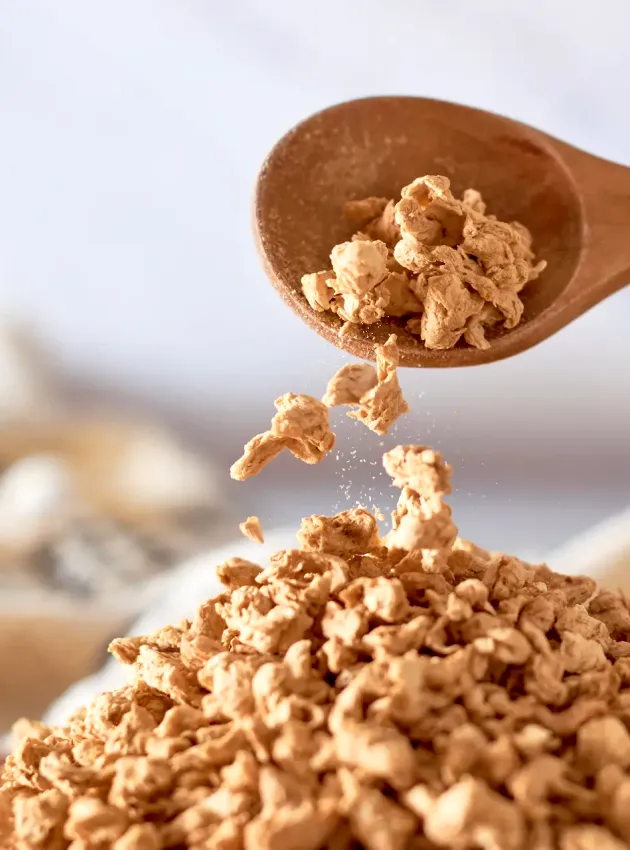
The Importance of Fibre in Your Diet: A Comprehensive Guide
Dietary fibre is a crucial part of our diet, but have you ever wondered what it really does for us? In this article, we'll explore the many health benefits of fibre. We'll see how it helps keep our digestive system in good shape and give you easy tips to incorporate more fibre into your everyday diet.
Why is Fibre Essential?
1. Improved Digestion
Fibre is a true ally for your digestive system. It helps maintain a regular digestive rhythm by increasing stool bulk and making it easier to pass (Anderson and al., 2009). This means it can greatly help in preventing constipation.
Moreover, eating foods high in fibre is beneficial for your gut microbiome, the community of microorganisms living in your intestines. A healthy microbiome aids in better nutrient absorption your body needs and can reduce inflammation in the intestines.
2. Weight Management
Looking for a partner in managing your weight? Fibre might be the answer. Foods high in fibre help you feel full longer, which can assist in avoiding snacking between meals (Mayo Clinic Staff, 2021).
And there's more: fibre also slows down sugar absorption. This means your blood sugar levels stay more stable, which is super important if you're looking to avoid those sudden cravings for sugar or snacks. In short, eating more fibre-rich foods can be an excellent strategy for controlling your appetite and managing your weight.
3. Blood Sugar Regulation
When it comes to controlling your blood sugar, fibres are superheroes. They are particularly useful for people with diabetes or those at risk of developing it (Slavin, 2005). How does this work? Fibres slow down how your body absorbs sugar after you eat. This means they help prevent your blood sugar from spiking right after meals.
Additionally, they make your body more responsive to insulin, the hormone that regulates blood sugar. So, by adding a variety of fibre-rich foods to your daily diet, you could help prevent type 2 diabetes.
4. Heart Health
Eating enough fibre can do a lot of good for your heart. Did you know that it can help lower your cholesterol levels? Lower cholesterol means a reduced risk of developing heart disease (American Heart Association, 2020). But that's not all.
Fibre also plays a significant role in regulating your blood pressure and reducing inflammation in your body. Both factors are crucial for preventing strokes and other heart and blood vessel-related issues.
How to Add More Fibre to Your Diet?
1. Fruits and Vegetables
- Snack Smartly: Keep fruits like apples, bananas, or oranges handy for a healthy snack. You can also prepare carrot sticks or broccoli in advance for nibbling.
- Nutritious Smoothies: Start your day with a nutritious smoothie. Blend your favorite fruits with yogurt or plant-based milk, and add green vegetables like spinach or kale for extra fibre.
- Vegetables in Main Dishes: Incorporate vegetables like bell peppers and zucchinis into your main dish recipes, such as stir-fries, soups, and casseroles.
2. Whole Grains
- Recipe Swaps: Use brown rice or quinoa instead of white rice in your recipes. These whole grains offer more fibre and nutrients.
- Whole Grain Bread for Sandwiches: Choose whole grain bread for your sandwiches, increasing your fibre intake and giving a richer texture.
- Breakfast Cereals: Opt for whole grain cereals for breakfast, like oatmeal or cereals made from whole grains.
3. Legumes
- Enriched Salads: Add beans, lentils, or peas to your salads for a protein and fibre boost.
- Meat Substitutes: Use legumes as meat substitutes in recipes like chili, vegetarian burgers, and tacos.
- Protein Snacks: Prepare hummus or crispy chickpea or other legumes for a protein-rich snack to enjoy with raw vegetables or whole grain crackers.
Integrating Fibre Into Your Diet
- Start Gradually: Incorporate at least two fibre-rich foods into your meals to slowly increase your fibre intake and avoid bloating.
- Drink at least 2 litres of water per day: Water is absorbed by dietary fibre, which then makes stools softer and easier to pass.
- Diversify Fibre Sources: Include at least one different high-fibre food in each meal and snack. Rotating fibre sources helps you explore a variety of available foods.
Fibre is an essential element for a healthy and balanced diet. It's not just about improving digestion but also contributes to weight management, heart health, and blood sugar regulation. Want to learn more about incorporating fibre into your diet or seeking personalized advice? Contact a registered dietitian at TeamNutrition today. Our nutrition experts will guide you towards healthy eating choices tailored to your specific needs.
References
- Health Canada. (2022). Canada's food guide. Retrieved from https://www.canada.ca/en/health-canada/services/canada-food-guide.html
- Mayo Clinic Staff. (2021). Dietary fiber: Essential for a healthy diet. Retrieved from https://www.mayoclinic.org/healthy-lifestyle/nutrition-and-healthy-eating/in-depth/fiber/art-20043983
- American Heart Association. (2020). Whole Grains, Refined Grains, and Dietary Fiber. Retrieved from https://www.heart.org/en/healthy-living/healthy-eating/eat-smart/nutrition-basics/whole-grains-refined-grains-and-dietary-fiber
- Anderson, J.W., Baird, P., Davis, R.H., Ferreri, S., Knudtson, M., Koraym, A., Waters, V., & Williams, C.L. (2009). Health benefits of dietary fiber. Nutrition Reviews, 67(4), 188-205. doi:10.1111/j.1753-4887.2009.001






